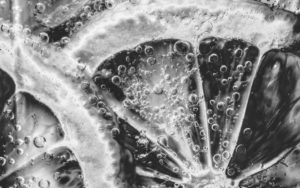With an array of potential applications and many outstanding questions, the skin microbiome is a land of untapped riches. Skin hydration is a pursuit of many, whether for cosmetic and beauty purposes or due to persistent conditions such as eczema. Dr Katerina Steventon investigates the role of the skin microbiome in finally achieving facial hydration.
It is widely known and understood that our skin is the front line barrier against external, harmful factors from the environment and is thus essential for the health of our body. The skin surface is an ecosystem colonized by microorganisms; diverse and complex microbial communities residing in skin structures, such as hair follicles, sebaceous or sweat glands, with distinct biological conditions. Most skin microbes are considered to be commensal organisms, but the true impact and potential role of microbes on human health is yet to be properly explored. An example of this is how the skin microbiome can change the hydration of the facial skin.
The uniqueness of facial skin
The face is directly exposed to the external environment and facial skin is prone to dryness. Yet, is there a link between facial skin hydration and the microbes living at the surface of our body?
We understand that skin barrier properties maintaining hydration of the skin are attributed mainly to the most upper layer of the skin – the stratum corneum. Dry skin with low hydration is prone to wrinkles, and commonly has a scaly, rough texture with cracking, itching and less flexibility compared to normal skin. Hydration has an effect on both the skin’s clinical and biophysical parameters, namely trans-epidermal water loss (TE WL), skin roughness, and the skin microbial community.
WL), skin roughness, and the skin microbial community.
Yet, the relationship between hydration levels and the microbial community in the human skin has not been extensively studied, although initial research1 has shown that there is high variability between individuals. We must remember that the ‘normal’ skin microbes present on any one individual vary between body sites, all with different hydration levels.
“Yet, is there a link between facial skin hydration and the microbes living at the surface of our body?”
We are at the infancy of understanding how facial microbiota impacts skin health. We understand that the face has distinct facial zones with a different barrier function, and that facial microbiota is likely to pre-determine skin conditions with some areas of the face more prone to these conditions than others. This understanding is likely just the start in fully recognizing the realm of the possible.
Creating the facial atlas
New research methods, such as novel continuous mapping, that can determine skin hydration and barrier function could help to define the different environments for bacterial species in the future. 2 Research into trans-epidermal water loss (TEWL) and skin capacitance on 30 pre-defined facial sites (the forehead, cheek, jaw and eye areas), combined with digital images, generated the first atlas of continuous visual maps of non-invasive skin parameters. These maps have, for the first time ever, confirmed the complexity of facial skin hydration and barrier in different ethnic groups. They have also shone a light on the remarkable fact that distinct differences exist within the areas on the face. Further research has to consider other biophysical characteristics, such as pH, temperature, sebum and skin topography, that will also have an influence on the microbial communities.
“However, the effects of cosmetic products known to increase skin hydration on the skin microbiome is minimal.”

In healthy skin, the microbial communities are considered to be largely stable over time despite the skin’s continual exposure to different, and at times harsh, external environments and climates. This includes the products and cosmetics applied in the hope for improved skin health and quality. We understand that ethnic differences may be due to endogenous factors like immunity and genetics, as well as dietary choices and lifestyle factors.
So far, research of skin microbiome in patients with deficient immunity, in groups with normal, sensitive and aged skin, and in patients with atopic dermatit
is, has suggested that the delicate balance of the skin microbiome may have a strong influence on the functional differences between healthy, aged and diseased skin health and quality. We understand that ethnic differences may be due to endogenous factors like immunity and genetics, as well as dietary choices and lifestyle factors.
So far, research of skin microbiome in patients with deficient immunity, in groups with normal, sensitive and aged skin, and in patients with atopic dermatitis, has suggested that the delicate balance of the skin microbiome may have a strong influence on the functional differences between healthy, aged and diseased skin
Can skincare change the microbiome?
The use of antibiotics, soaps, skincare and personal care products can influence the skin microbiome. However, the effects of cosmetic products known to increase skin hydration on the skin microbiome is minimal.
In fact, a study comparing bacterial communities of facial skin areas with two different skin hydration levels confirmed that the microbial communities in dry skin do not shift to resemble those present in normal skin just by increasing skin hydration. This represents a seismic shift in how we treat and care for dry skin. Future formulations should reflect new research in line with the wider trend of skincare personalisation. It is possible that the climate or specific ingredients, like preservatives, may have a higher impact on facial microbiome.3
On a final point, the effectiveness of the skin barrier is known to define our skin health. The functionality of skin barrier is linked to the most upper layer of the skin (the stratum corneum) that sheds regularly. However, in recent years the idea of the skin microbiome that lives on the surface of the stratum corneum being the most upper layer of our body, and therefore, forming the living interface between our body and the environment has been considered plausible. This hypothesis gives the research into the nuances of the microbial envelope, the skin microbiome, associated biofilms, and simply the quantity and quality of diverse bacterial species living on the surface of our skin, yet another dimension to explore in years to come. end
Want to find out more about the skin microbiome? Find out about the skin layers here and see more on our Instagram here.
[1] https://www.ncbi.nlm.nih.gov/pmc/articles/PMC5911989/
